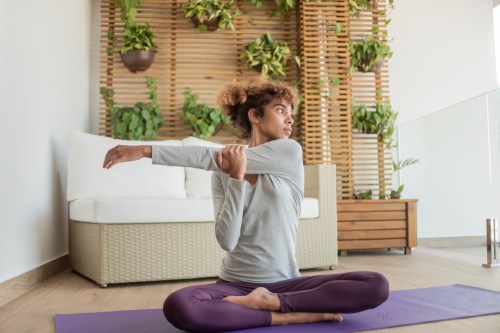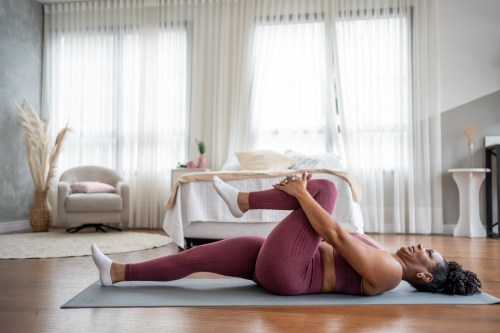The ‘Big 3’ Ways To Boost Your Post-Workout Recovery As You Age
How exercise recovery and age are linked, and what you can do to get back to workouts faster as you get older.

As we get older, how we stay in shape often changes. Co-ed soccer leagues and HIIT classes might be replaced by long walks and low-impact movement sessions. Our bodies feel different, and how we want to move them isn’t always the same as it was in our 20s.
Experts in This Article
exercise physiologist at NYU Langone’s Sports Performance Center
What most of us pay less attention to, however, is what happens after a workout.
According to Heather Milton, a sports health expert and exercise physiologist supervisor at NYU Langone’s Sports Performance Center, a numberofstudies comparing the recovery times of 20-year-olds to 60- and 70-year-olds indicates that more time is needed for your body to repair itself as you age. “If you ask both age groups to do a 50-pound back squat, just 48 hours later the 20-year-olds will be able to squat with the same amount of weight. The 70-year-olds, however, might not be able to do as much,” Milton says. “You can’t generate the same amount of force.”
Milton believes these changes in recovery time post-workout have less to do with unchangeable forces related to aging, and more to do with lifestyle changes—which means there are ways we can actively shift our habits to help our bodies recoup faster.
Best practices for boosting muscle recovery as you age
1. Drink up
As with many things in life, hydration is the not-so-secret ingredient to boosting muscle recovery. “The drive for thirst is blunted as you get older, which increases the chances of being dehydrated,” Milton says. “Our muscles are 70 percent water, and we need that water for metabolic processes.” If we thoughtfully optimize hydration as we age, remembering that by the time we are thirsty we are actually already dehydrated, we can improve our muscle recovery.
2. Eat a well-rounded diet
Next up: nutrition. “As we get older, we need foods that are easier to digest and utilize,” Milton says. Though there’s a lack of robust evidence indicating that specific nutrients should be emphasized for muscle recovery, she believes older adults could use improvement in nutrient intake generally. For support in accomplishing this goal, you might consider requesting help from a dietitian or doctor.
3. Get your Zzzs
Finally, those hoping to boost muscle recovery as they age should prioritize rest. “Sleep patterns change as you age, and sleep is one of the most powerful tools we have for recovery,” she says. “If sleep is shortened or depth of sleep is impacted, that will be a problem.”
Every body is unique, so experiment with different strategies—you can try everything from shiatsu to ashwagandha to a dedicated morning routine—to figure out what helps you catch the most shut-eye.
This gentle yoga flow will prime your body for sleep:
How do you know when it’s safe to exercise again?
As the years go by, you will need more time to recover between workouts. But how do you know what’s enough?
According to Milton, the best test for muscle recovery is a lack of (or even just an improvement in) muscle soreness. “Wait until your peak of soreness is over,” she says. She also recommends not doing the exact same exercises multiple days in a row: “The nerve connection to the muscle will still be fatigued, and it will be an inefficient workout until recovery has begun.”
On the flip side, Milton says you shouldn’t wait too long between sessions either. “Waiting more than one week is too much,” she says. You need a certain amount of consistency in your routine to see strength gains.
Choose your workout with recovery in mind
To get the most bang for your buck, Milton recommends focusing your workouts on moderate-intensity cardiovascular exercises like walking, cycling, or canoeing as you age. “These exercises produce less soreness and are good for both muscle and cardiovascular health.” A good way to tell if an activity fits into this category? It should be something you can do for more than 10 minutes without fatigue. “If you can answer a question but not talk in full sentences, that is moderate-intensity exercise.”
Ultimately, getting older doesn’t necessarily mean you have to give up your favorite types of exercise, or spend large swaths of your time in recovery rather than moving your body. Setting yourself up strategically will get you back in the gym in no time!
Oh hi! You look like someone who loves free workouts, discounts for cutting-edge wellness brands, and exclusive Well+Good content. Sign up for Well+, our online community of wellness insiders, and unlock your rewards instantly.
Sign Up for Our Daily Newsletter
Get all the latest in wellness, trends, food, fitness, beauty, and more delivered right to your inbox.
Got it, you've been added to our email list.










